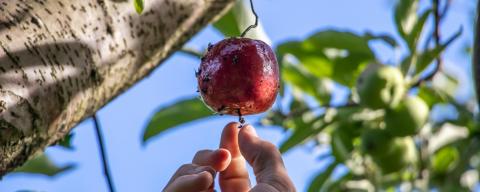There is currently little data on pests observed in New Hampshire hemp crops; further studies are needed to categorize potential pests. Based on reports from the Northeastern United States and Canada, several insect and mite pests that may be of concern to New Hampshire hemp growers are outlined below:
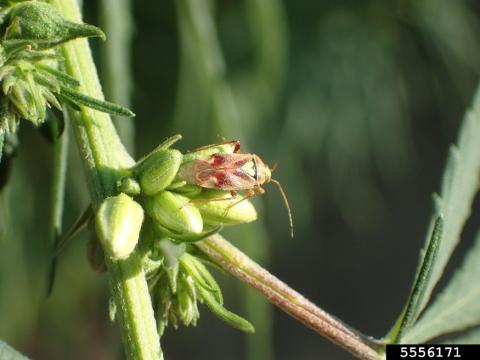
Adult tarnished plant bug on hemp (Whitney Cranshaw, CSU, Bugwood.org).
Lygus sp.
A small, greenish-brown, flattened insect (~¼ inch long), with piercing-sucking mouthparts. Tarnished plant bugs (TPB) feed by sucking fluid from plants, particularly areas of new growth. Feeding may cause discoloration, distortion, and stunting of growth. Symptoms of damage can also include flower abortion and seed deformities. Damage is often minimal, but this is a pest of concern for producers of hemp seed. TPB feeding can disrupt and reduce seed production and quality.
green peach, potato, rice root, cannabis
Growers are likely already acquainted with common aphid species, such as the green peach aphid. Additional species, including the rice root aphid and cannabis aphid, can prey on industrial hemp plants. Aphids utilize piercing-sucking mouthparts to pierce plant tissues and extract sap. High population levels may cause a loss of plant vigor. While feeding, aphids secrete a sticky substance known as “honeydew”, promoting the growth of unwanted fungi and leading to the development of sooty mold. Shed aphid exoskeletons will also diminish crop quality, particularly as plants mature and become more resinous, collecting these contaminants.
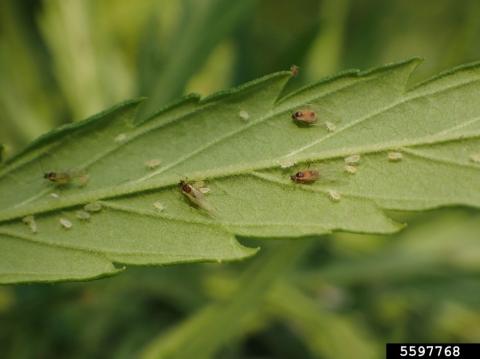
Multiple life stages of cannabis aphid (Melissa Schreiner, Colorado State University, Bugwood.org)

Cannabis aphid cast skins (Whitney Cranshaw, Colorado State University, Bugwood.org)
Phorodon cannabis
A recently recognized pest in North America that is now prevalent in Colorado and other hemp production regions. Coloration ranges from light green and pale pink to light brown. Cannabis aphid populations build slowly throughout the season, and high populations reduce plant vigor, slow plant growth, and can lead to wilting and yellowing.
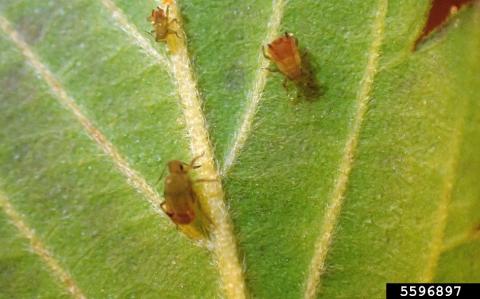
Rice root aphid nymphs (Whitney Cranshaw, Colorado State University, Bugwood.org)
Rhopalosiphum rufiabdominale
Rice root aphid is associated with indoor production of Cannabis sativa being grown as a high-THC crop and has been observed in indoor cultivation throughout the country. To date, there have been no reports of this pest on outdoor-grown hemp crops in North America. Further research on hemp soil insect pests is needed.

Adult Japanese beetle on hemp (Whitney Cranshaw, Colorado State University, Bugwood.org)
Popillia japonica
Adult Japanese Beetles feed on leaves, skeletonizing them, as well as on developing flowers. Large populations may result in complete plant defoliation. Grubs may cause feeding damage to the roots before emergence; however, turf grass is the preferred habitat for larvae.
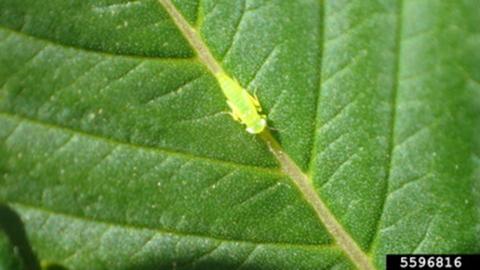
Potato leafhopper nymph on hemp (Whitney Cranshaw, Colorado State University, Bugwood.org)
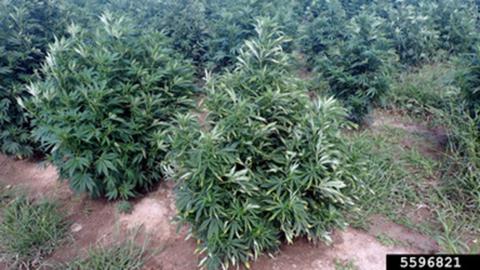
Foliar symptoms of hopperburn (Whitney Cranshaw, Colorado State University, Bugwood.org)
There are hundreds of leafhopper species found in New Hampshire, 40 of which are economically significant due to disease transmission or feeding activities. The potato leafhopper (Empoasca fabae) is likely the most common leafhopper pest of hemp. This pest migrates north each summer on winds and storm systems. Potato leafhoppers use piercing-sucking mouthparts to extract fluid from leaves while simultaneously injecting a toxin that clogs plant vascular tissue. Leaves with feeding damage turn yellow and eventually brown and die back. Because of the scorched appearance of leaves post-feeding, the term “hopperburn” is used. Management thresholds and the impact of potato leafhopper in hemp are still unknown and plant injury response may vary between cultivars.
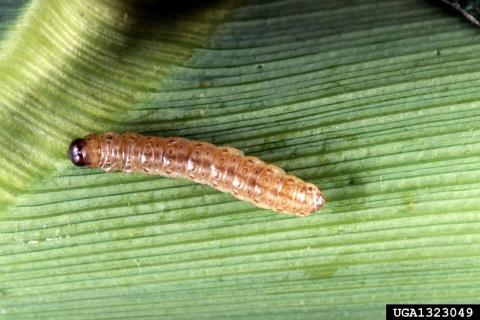
European corn borer (Keith Weller, USDA Agricultural Research Service, Bugwood.org)
Ostrinia nubilalis
Hemp is not a preferred host of ECB; however, if a preferred host is not available, adult moths will lay eggs on hemp plants. The caterpillars feed within the stalks and stem, which can cause breakage. This pest overwinters as full-grown larvae in crop residue. Two generations of European corn borer occur in southern New Hampshire, and one generation occurs in northern New Hampshire (late June/early July). Second generations may cause damage to hemp buds. Additional monitoring and management may be required if hemp production is adjacent to corn fields.
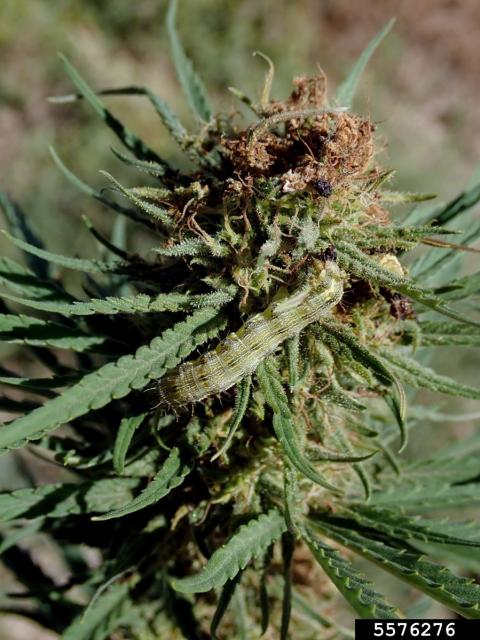
Corn earworm caterpillar and associated bud damage (Whitney Cranshaw, Colorado State University, Bugwood.org)
Helicoverpa zea
Corn earworm is a pest of concern for hemp producers, particularly those growing cannabinoid varieties for smokeable flower or CBD production. Feeding wounds and tunneling into buds create an excellent entry point for pathogens which can cause bud rots, and introduce frass (insect feces) which can further contaminate buds.
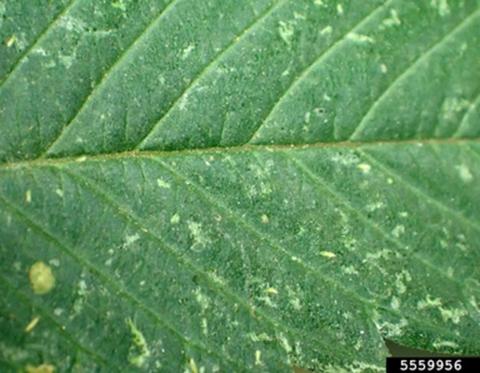
Thrips damage to hemp (Whitney Cranshaw, Colorado State University, Bugwood.org)
Onion thrips (Thrips tabaci) and Western flower thrips (Frankliniella occidentalis) have been observed as pests of hemp. Feeding damage can result in leaf scarring and leaf distortion when feeding occurs on developing leaves. Symptoms of thrips feeding include stippling (small white areas indicate feeding areas) and small dark spots (feces). In outdoor field settings with populations of natural predators, thrips are unlikely to reach economically impactful levels. Thrips populations may rise to impactful levels in semi/fully protected agriculture environments if populations are left unmanaged.
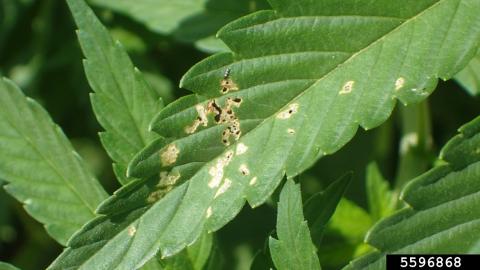
Flea beetle damage to hemp (Whitney Cranshaw, Colorado State University, Bugwood.org)
Flea beetles are a pest of minor concern for hemp crops; however, high populations of flea beetles can cause significant feeding damage to seedlings. Feeding damage is characterized by a high density of feeding wounds, known as “shotholes”. The red-headed flea beetle (Systena frontalis) was noted as the most common insect pest on two New York hemp farms.
Other insects observed in hemp include cutworms, stink bugs, grasshoppers, armyworms, and spotted cucumber beetles.
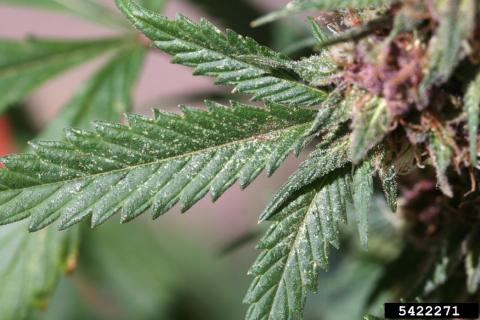
Two-spotted spider mite damage leaves (Whitney Cranshaw, Colorado State University, Bugwood.org)
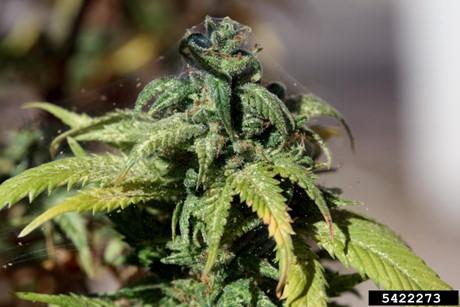
TSSM bud infestation (Whitney Cranshaw, Colorado State University, Bugwood.org)
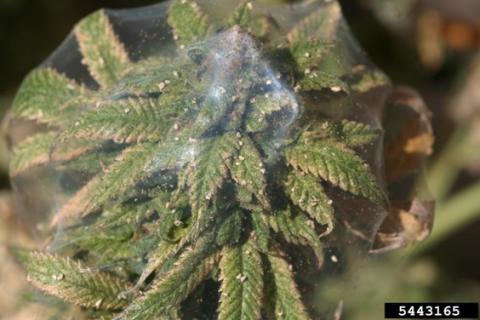
Severe TSSM infestation on indoor-grown hemp plant with clear webbing (Whitney Cranshaw, Colorado State University, Bugwood.org)
Tetranychus urticae
Two-spotted spider mites (TSSM) can occur in both indoor and outdoor hemp production. Adults have a pair of dark spots on their bodies. This species feeds on numerous plant species, increasing its ability to move between fields and crops. TSSM feed on plant cell contents, leaving leaves with a speckled appearance and reduced photosynthetic capacity. High populations of TSSM will leave an easily visible webbing which can cause additional cosmetic economic loss. Spider mites prefer hot and dry conditions and water-stressed plants, so improved water management and dust-free environments can reduce instances of mite infestation.
Aculops cannibicola
Hemp russet mites have not yet been found in New England but are a pest of hemp in western states. They are very small and are usually found on the underside of leaves but may develop on stems. Their feeding causes bronzing, upward rolling, and brittle leaves, though most damage is to developing buds.
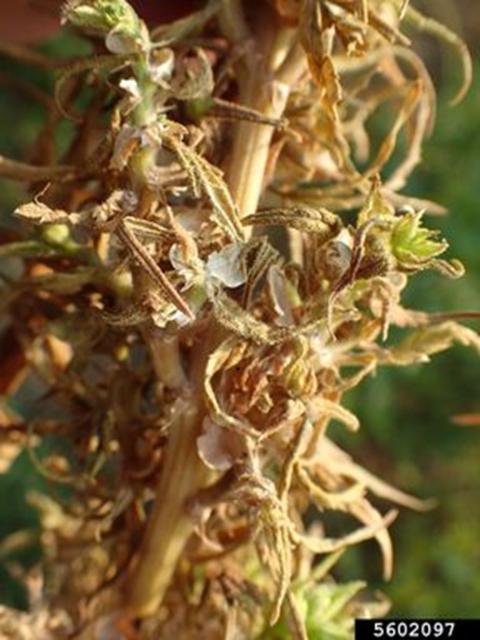
Seed damage from birds (Whitney Cranshaw, Colorado State University, Bugwood.org)
Birds and mammalian herbivores may become pests of hemp crops. Foliar feeding as well as damage to flowers and seed heads are the primary concerns. Exclusion barriers or other methods of dissuading feeding should be considered when economically impactful damage is a concern.
Close to a century of prohibition on production and research has significantly limited the knowledge of hemp pest management strategies. Growers are encouraged to report observations and findings to their local Extension contact and remain informed about production practice developments.
Scout crops at regular intervals for early intervention and maintain these observations for your production records. Sampling should be thorough and representative of the production footprint. If possible, examine 5-10 plants in 5 -10 different areas of the field by sight or with a hand lens. Look for pests, beneficials, plant damage, signs of parasitism, etc. Scouting patterns could include transects, zig-zag, or diamonds. Record findings, take photos, and collect pests and damage if needed for later identification. Pheromone lures are commercially available for trapping and monitoring European corn borer and corn earworm populations.
Provide adequate nutrition and maintain soil pH, healthy plants are less susceptible to insect predation.
Transplants or early seeding allows a plant to be better established before the arrival of seasonal pests. If transplants are from off-farm sources they should be scouted thoroughly, and quarantined if necessary, before introducing them to your farm. Plant introductions are often the primary source of non-migratory pest species.
Proactive sanitation throughout the growing season will help reduce instances of pest pressure. Destroy crop residue following each harvest to avoid insect and disease overwintering.
Maintain a crop rotation when possible and avoid planting hemp next to crops that can act as an alternative host for pests of concern. The use of cover crops in a rotation may help reduce weed populations, build soil health, and retain nutrients. Limit the build-up of weeds in the field and on field edges. Weedy species provide habitat and cover for pest populations. Spring tillage and fall plowing should be considered as part of an integrated weed management plan.
| Pest | Biocontrol Options |
|---|---|
|
Tarnished Plant Bug |
Orius insidiosus, Deraeocoris brevis |
|
Aphids |
Aphidius colemani, Aphelinus abdominalis, Chrysoperla spp., Hippodamia spp. |
|
Japanese Beetle |
Tiphia vernalis, Heterorhabditis bacteriophora (nematodes) |
|
Potato Leafhopper |
Orius spp., lady beetles, spiders |
|
European Corn Borer |
Trichogramma ostriniae, Bacillus thuringiensis (Bt kurstaki) |
|
Corn Earworm |
Trichogramma pretiosum, Bt kurstaki, green lacewings |
|
Thrips |
Amblyseius cucumeris, Orius insidiosus, Neoseiulus barkeri |
|
Flea Beetles |
Ground beetles, Beauveria bassiana (fungus) |
|
Two-Spotted Spider Mite |
Phytoseiulus persimilis, Neoseiulus californicus, Amblyseius andersoni |
|
Hemp Russet Mite |
Amblyseius swirskii, Neoseiulus cucumeris |
|
Cutworms & Armyworms |
Bt kurstaki, Steinernema carpocapsae (nematodes), ground beetles |

Aphidius ervi ovipositing eggs in cannabis aphid mummy (Melissa Schreiner, Colorado State University, Bugwood.org)
Biological control agents can be an effective control for pest populations below a certain threshold. A successful biological control program is based on the correct identification of target pests and an understanding of their lifecycle. Work with your biological control supplier or Extension Field Specialist to determine appropriate controls.
The Environmental Protection Agency has a list of approved pesticides for use on hemp. Applicators are responsible for determining the current federal and state regulatory status and should contact their State Department of Agriculture or Extension service for assistance. Strict adherence to the pesticide label is the law.
Pollinator safety may need to be considered during flowering if pest control is warranted.
Colorado State University. 2018. Cannabis Aphid. https://webdoc.agsci.colostate.edu/hempinsects/PDFs/Cannabis%20aphid%20…;
Whitney Cranshaw, Suzanne Wainwright-Evans, Cannabis sativa as a Host of Rice Root Aphid (Hemiptera: Aphididae) in North America, Journal of Integrated Pest Management, Volume 11, Issue 1, 2020, 15, https://doi.org/10.1093/jipm/pmaa008
University of New Hampshire. (2018, June 25). New Hampshire at center of leafhopper universe. UNH Today. https://www.unh.edu/unhtoday/news/release/2018/06/25/new-hampshire-cent…
Kadie E Britt, Thomas P Kuhar, Whitney Cranshaw, Christopher T McCullough, Sally V Taylor, Benjamin R Arends, Hannah Burrack, Melissa Pulkoski, David Owens, Tigist A Tolosa, Simon Zebelo, Katelyn A Kesheimer, Olufemi S Ajayi, Michelle Samuel-Foo, Jeffrey A Davis, Nathan Arey, Hélène Doughty, Joanne Jones, Marguerite Bolt, Bradley J Fritz, Jerome F Grant, Julian Cosner, Melissa Schreiner, Pest Management Needs and Limitations for Corn Earworm (Lepidoptera: Noctuidae), an Emergent Key Pest of Hemp in the United States, Journal of Integrated Pest Management, Volume 12, Issue 1, 2021, 34, https://doi.org/10.1093/jipm/pmab030
Cranshaw, W., & Hazzard, R. (2018). Arthropod pests of hemp in the United States (2nd ed.). University of Vermont, Northwest Crops and Soils Program. https://www.uvm.edu/sites/default/files/Northwest-Crops-and-Soils-Progr…
Extension Services & Tools That Help NH Farmers Grow
Newsletters: Choose from our many newsletters for production agriculture
Receive Pest Text Alerts - Text UNHIPM to (866) 645-7010

